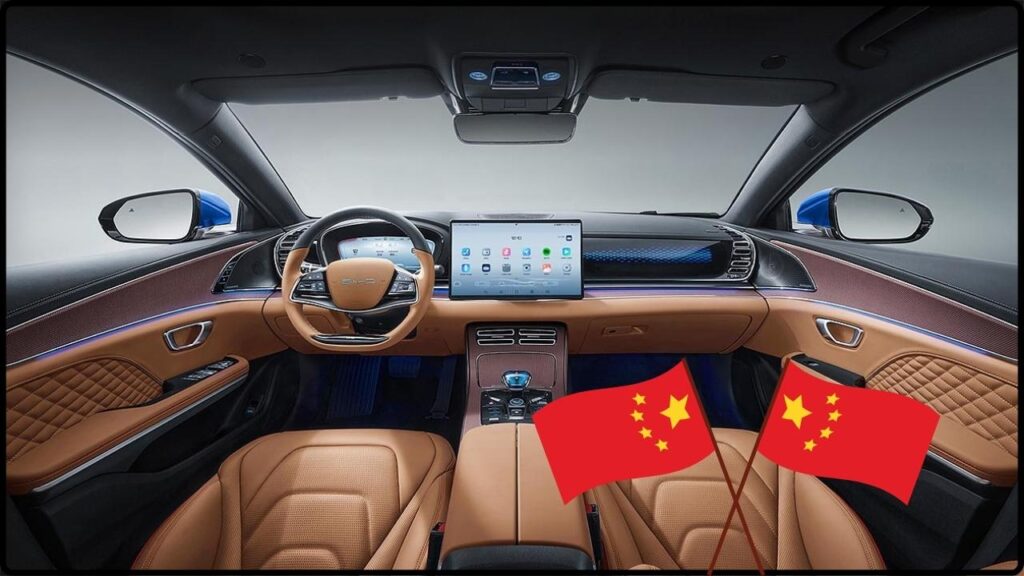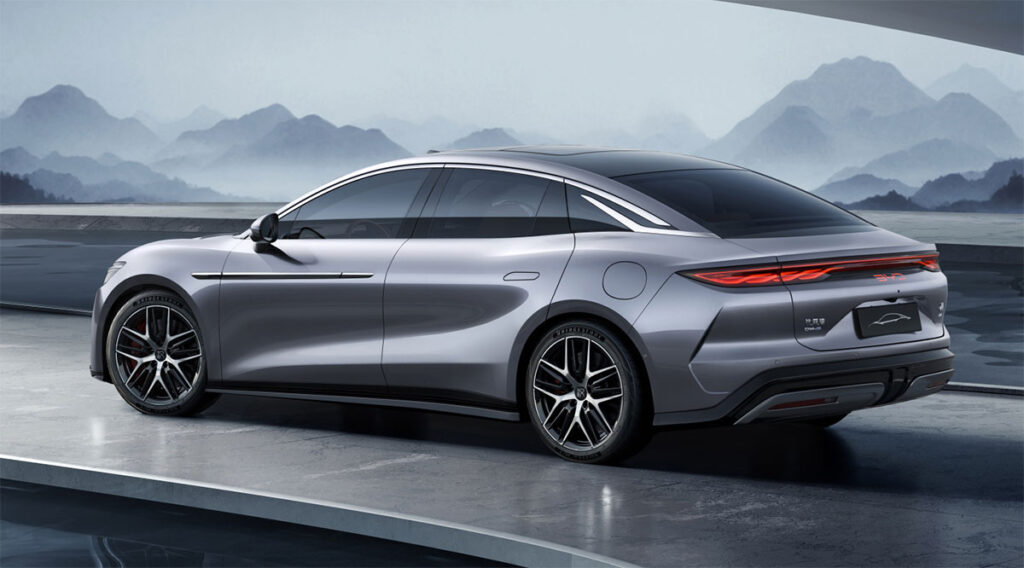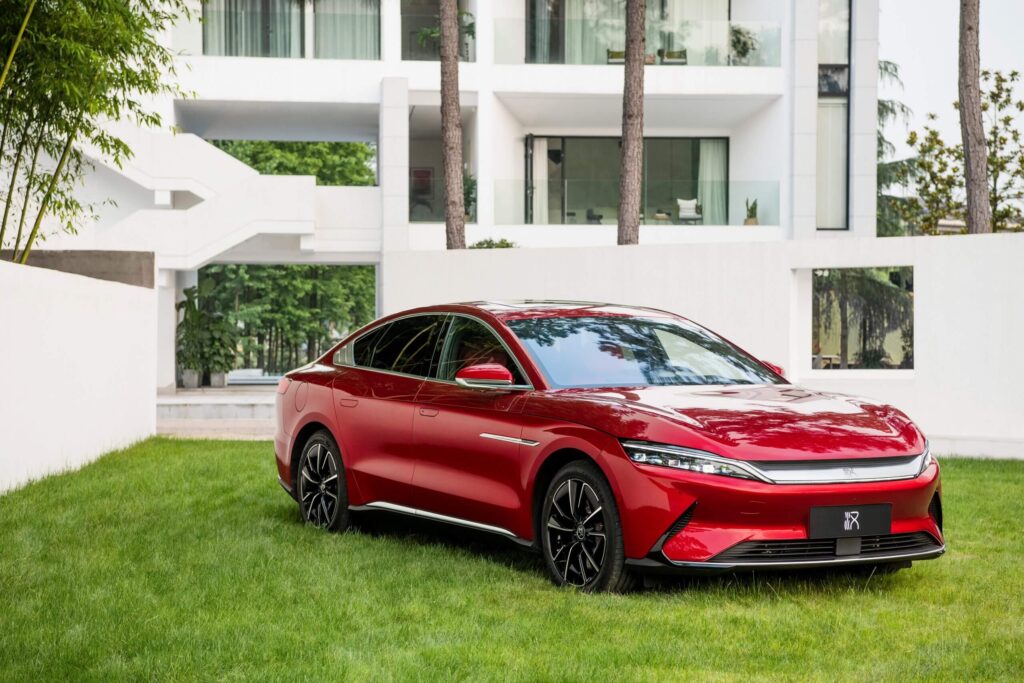
This Chinese Supercar Packs 1,086 Horsepower: The global electric vehicle (EV) race just got a turbo boost—and it’s coming from an unexpected corner. Chinese automaker BYD (Build Your Dreams) has rolled out two high-performance electric models—the Han L EV sedan and the Tang L EV SUV—that are shaking up the global automotive industry.
Why the fuss? Both models pack 1,086 horsepower (810 kW) and feature next-generation battery and charging technology. Even more shocking? They start at just $37,300 USD. That’s right—supercar performance at a fraction of the cost of U.S. or European rivals. If you thought EVs were only about being green, think again. These are ludicrously fast, wildly affordable, and they’re gunning for global dominance.
This Chinese Supercar Packs 1,086 Horsepower
BYD’s Han L and Tang L EVs, each with 1,086 horsepower, are not just fast—they’re a sign of a changing world. With supercar specs, ultra-fast charging, and unbeatable pricing, these vehicles are redefining what’s possible in EVs. They don’t just compete with Tesla, Porsche, or Lucid—they leapfrog them in value and accessibility. For the global auto industry, that’s more than a wake-up call. It’s a seismic shift. As BYD continues to grow internationally, U.S. automakers must take notice—not just of the specs, but of the business model behind them.
| Feature | Han L EV Sedan | Tang L EV SUV |
|---|---|---|
| Peak Power | 810 kW (~1,086 hp) | 810 kW (~1,086 hp) |
| 0–100 km/h | ~2.7 seconds | ~3.6 seconds |
| CLTC Range | 601–701 km | 560–670 km |
| Top Speed | ~305 km/h | ~287 km/h |
| Battery Platform | Super e-Platform 1.0 (1,000 V) | Super e-Platform 1.0 |
| Charging Speed | 10C charging (400 km in 5 mins) | Same as sedan |
| Price (Pre-sale China) | ~$37,300 USD | ~$38,700 USD |
| Official Website | BYD Global | BYD Global |
Understanding BYD: A Sleeping Giant Now Wide Awake
Founded in 1995 as a battery manufacturer, BYD has grown into the largest EV maker in the world, surpassing Tesla in total sales in 2023. What makes BYD unique is its full vertical integration—it designs and produces everything in-house, from batteries to semiconductors to electric drivetrains.
This level of control means BYD can innovate rapidly and keep costs low. Unlike legacy automakers, BYD doesn’t rely on third-party suppliers for key components. The result? High-performance electric vehicles that are affordable, scalable, and surprisingly luxurious.

Performance That Punches Above Its Price
With 810 kW (1,086 hp) of electric muscle and a top speed around 305 km/h, the Han L sedan is no slouch. Acceleration is stunning: 0 to 100 km/h in just 2.7 seconds, putting it squarely in the ring with performance kings like the Tesla Model S Plaid and Lucid Air Sapphire.
The Tang L, a full-sized electric SUV, uses the same drivetrain and still manages 0–100 km/h in a brisk 3.6 seconds, making it the fastest 7-seater SUV in its class.
What sets these cars apart isn’t just speed—it’s the price-to-performance ratio. Here’s how they stack up:
| Model | Power (hp) | 0–100 km/h | Price (USD) |
|---|---|---|---|
| BYD Han L | 1,086 | ~2.7 s | ~$37,300 |
| Tesla Model S Plaid | 1,020 | ~2.1 s | ~$89,990 |
| Lucid Air Sapphire | 1,200+ | ~1.89 s | ~$249,000 |
| Porsche Taycan Turbo S | 750 | ~2.6 s | ~$188,850 |
BYD’s models offer supercar-level specs at entry-level luxury prices. This makes them a real threat to U.S. auto dominance, especially in global markets where price sensitivity is high.
Built on Innovation: The Super e-Platform 1.0
Both the Han L and Tang L ride on BYD’s Super e-Platform 1.0, a next-gen EV architecture featuring:
- 1,000 V High-Voltage System – Enables ultra-fast DC charging
- 10C Charging Rate – Adds 400 km of range in just 5 minutes under optimal conditions
- Blade Battery Technology – Safer, cooler, longer-lasting LFP battery packs
- Efficient Inverters and Motors – Designed for high energy conversion with minimal loss
These aren’t just fast cars—they’re technologically sophisticated machines, designed for longevity, safety, and performance.
Blade Battery: The Game-Changer
BYD’s in-house Blade Battery is a Lithium Iron Phosphate (LFP) chemistry that is:
- More stable and fire-resistant than conventional lithium-ion batteries
- Less reliant on rare or controversial minerals like cobalt and nickel
- Capable of over 3,000 charge cycles with minimal degradation
Thanks to the flat, blade-shaped cells, the battery pack offers better space utilization and thermal performance. Safety tests—including nail penetration—show virtually no risk of combustion, even under stress.
This Chinese Supercar Packs 1,086 Horsepower vs. The World: What Makes It a Real Threat
Unlike other Chinese startups that only make headlines with concepts, BYD is already global. It manufactures in China, Thailand, Brazil, and recently opened EV facilities in Hungary and Uzbekistan. It’s delivering buses in the U.S. and passenger cars in Europe and South America.
BYD’s key strengths include:
- Low production cost
- Rapid R&D cycles
- In-house battery production
- Proven supply chain logistics
Tesla, General Motors, Ford, and even German luxury brands now face a growing, well-funded competitor with international momentum.

Interior Tech & Features
Despite the aggressive pricing, BYD hasn’t cut corners inside. Standard and optional features include:
- 15.6” rotating infotainment screen (landscape/portrait switch)
- Intelligent voice assistant and gesture controls
- Nappa leather interiors
- Heads-up display (HUD)
- Advanced Driver Assistance Systems (ADAS) like adaptive cruise, lane keeping, auto park
- 5G connectivity and over-the-air (OTA) software updates
This isn’t your average EV cockpit—it’s a premium digital experience.

Charging Experience & Infrastructure
BYD’s EVs are compatible with ultra-fast DC charging stations due to their 1,000 V architecture. With a 10C charge rate, drivers can replenish up to 400 km in 5 minutes, assuming proper infrastructure.
In markets like Europe and China, BYD partners with:
- Shell Recharge
- Ionity (Europe)
- China Southern Grid EV Infrastructure
While such ultra-high-speed stations are still rare in the U.S., they are expanding fast.
After-Sales Support and Warranty
In China and Europe, BYD offers:
- 6-year / 150,000 km vehicle warranty
- 8-year / 200,000 km battery warranty
- Regular OTA software updates
- Access to service centers through local partnerships
Resale value is still emerging due to the newness of these models, but early indicators suggest they retain value well in domestic markets.
The Global Rollout Strategy
While these high-performance EVs are currently China-exclusive, BYD has:
- Started pilot programs in Germany, France, the UK, and Norway
- Exported to Brazil, Thailand, and Australia
- Plans to expand to North America by 2026, pending regulatory approval
The U.S. auto industry is watching closely. BYD has already built brand trust in the commercial EV segment (electric buses) and could quickly leverage that reputation.
Practical Advice: Should You Buy or Watch?
Buy If:
- You live in China, Southeast Asia, or Europe
- You want luxury speed on a budget
- You need real range without the Tesla price tag
Watch If:
- You’re in the U.S. or Canada
- You want to compare future pricing or EV tax credits
- You’re in the auto business and want to gauge disruption risk
It’s Official: Japan’s New Zero-Emission Car Could Make Gas-Powered Vehicles Obsolete
Confirmed – U.S. Makes Radical Decision on Autonomous Vehicles—Tesla and GM Are Already Gearing Up
Forget Oil—The Real Money Is in the Ground: Mining’s Rise as the Next Economic Titan











